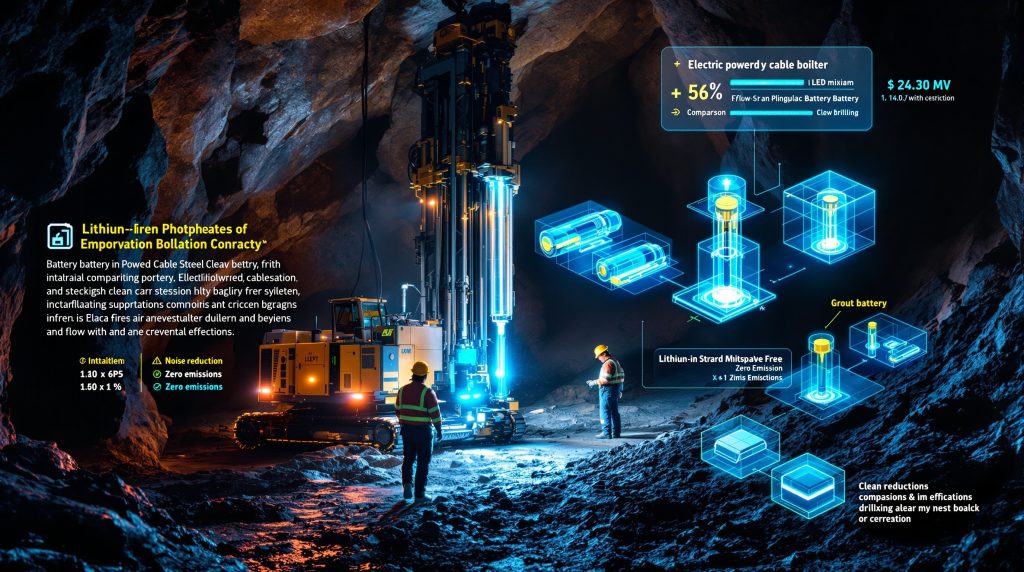Understanding Cable Bolting Technology in Underground Operations
Cable bolting represents a fundamental rock reinforcement methodology in underground mining operations, where multi-strand steel cables are installed and secured within rock formations to provide critical structural stability. This technology has become essential for maintaining safe working environments in underground mines, particularly in areas where traditional support methods may prove insufficient.
The battery-powered cable bolter emerges as a revolutionary advancement in this established field, addressing longstanding limitations of diesel-powered equipment in confined underground spaces. Traditional diesel systems generate significant heat, produce harmful emissions, and create excessive noise levels that compromise both worker safety and operational efficiency.
Core Components and Operational Mechanics
Modern cable bolting systems integrate sophisticated drilling mechanisms with automated grouting systems to achieve precise rock reinforcement. The process involves installing multi-strand steel cables up to 25 meters in length within carefully positioned holes, followed by high-pressure grouting that secures the cables within the rock matrix.
The DS422iE battery-powered cable bolter incorporates an on-board automatic grout mixer with a 600kg capacity grout silo, reducing manual handling requirements between installations. This integrated approach maintains consistent grouting quality while minimising operator exposure to hazardous conditions.
Source: Engineering & Mining Journal, "Sandvik Introduces the World's First Battery-Powered Cable Bolter," November 4, 2025
How Battery-Electric Technology Transforms Underground Mining Safety
Eliminating Diesel Emissions in Confined Spaces
Battery-electric cable bolters deliver zero-emission operation, fundamentally transforming air quality management in underground mining environments. The elimination of diesel particulate matter represents a significant advancement in occupational health protection, particularly in confined spaces where ventilation systems struggle to manage combustion byproducts effectively.
The revolutionary electric driveline system consumes no fuel while generating substantially less heat compared to conventional diesel-powered equipment. This heat reduction provides dual benefits: improved working conditions for operators and reduced strain on mine ventilation infrastructure.
Furthermore, these advancements align with broader mining innovation trends that prioritise sustainable technology adoption across mining operations.
Advanced Battery Chemistry for Mining Applications
Lithium-iron phosphate (LFP) battery technology has been specifically selected for underground mining applications due to its superior safety profile and thermal stability characteristics. This chemistry provides maximum safety underground while delivering optimal productivity and equipment utilisation rates.
LFP batteries demonstrate exceptional temperature stability and enhanced fire resistance compared to traditional lithium-ion technologies, making them particularly suitable for the challenging thermal conditions encountered in underground mining operations.
Battery-electric cable bolters eliminate diesel particulate matter exposure while maintaining continuous operational productivity, delivering measurable improvements in both worker health outcomes and equipment performance metrics.
Source: Engineering & Mining Journal, November 4, 2025
Technical Specifications: What Makes Battery Cable Bolters Effective?
Power and Performance Metrics
| Specification | DS422iE Capability | Operational Advantage |
|---|---|---|
| Operating Duration | Up to 4 hours continuous | Extended shift coverage |
| Cable Installation Range | Up to 25 meters | Comprehensive reinforcement capability |
| Grout Silo Capacity | 600kg automated system | Reduced manual handling |
| Cabin Visibility | 55% increase vs predecessor | Enhanced operator safety |
| Battery Chemistry | Lithium-iron phosphate (LFP) | Maximum underground safety |
The Charging While Drilling technology enables full drilling cycle execution on battery power, with integrated charging capabilities that extend operational time beyond the base four-hour capacity. This proprietary system maintains productivity while eliminating dependency on continuous grid power availability.
Automation and Digital Integration Features
Advanced automation systems reduce operator workload through one-hole automation capabilities, while tele-remote operation functionality enables deployment in hazardous areas where direct operator presence poses safety risks.
The equipment incorporates repeatable bolting accuracy systems that ensure consistent installation quality across multiple cable bolt placements. Full fan automation manages environmental control automatically, optimising working conditions without requiring manual operator intervention.
These technological developments demonstrate how ai in mining technology continues to enhance operational efficiency and worker safety across the industry.
Source: Engineering & Mining Journal, November 4, 2025
Why Are Mining Companies Adopting Battery-Powered Cable Bolters?
Operational Independence and Grid Flexibility
Off-grid operational capability addresses critical infrastructure challenges faced by mining operations with unstable electrical grids. This independence enables continuous rehabilitation work during power outages or grid maintenance periods, maintaining productive schedules regardless of external power availability.
The ability to operate independently of underground electrical infrastructure provides strategic advantages in remote mine sections where power distribution may be limited or unreliable. This operational flexibility translates directly into improved equipment utilisation rates and reduced downtime.
Economic Benefits Beyond Equipment Costs
Battery-electric systems eliminate fuel transportation and storage requirements, reducing both logistical complexity and associated safety risks. The absence of diesel engine components significantly reduces maintenance intervals and complexity, translating into lower total cost of ownership over equipment lifecycles.
Equipment utilisation improvements result from reduced heat generation, which minimises thermal stress on both operators and surrounding infrastructure. This thermal advantage extends productive working hours and reduces cooling system operational costs.
The transformative ability to continue rehabilitation work off-grid using battery power addresses fundamental infrastructure challenges while delivering unprecedented operational independence for mining companies.
Moreover, these economic advantages support the growing adoption of data-driven mining operations that rely on continuous equipment monitoring and optimisation.
Source: Engineering & Mining Journal, November 4, 2025
Installation Process: How Battery Cable Bolters Work in Practice
Step-by-Step Cable Bolt Installation
Positioning and Setup Phase
- Automated positioning systems ensure precise hole alignment for optimal cable placement
- Tele-remote capabilities enable safe operation from protected locations during hazardous conditions
- Ergonomically designed cabin provides 55% increased visibility for enhanced operator awareness
Drilling Operations Execution
- Battery-powered drilling maintains consistent torque throughout the installation cycle
- One-hole automation reduces manual intervention requirements and operator fatigue
- Real-time monitoring systems track drilling parameters for quality assurance
Cable Installation and Grouting Completion
- Automated cable feeding mechanisms ensure proper placement within drilled holes
- On-board grout mixing systems deliver consistent grouting quality with 600kg capacity for extended operations
- Full fan automation manages environmental conditions throughout the installation process
Quality Control and Verification Methods
The repeatable bolting accuracy system ensures consistent installation parameters across multiple cable bolt placements. Digital monitoring capabilities track installation parameters in real-time, providing documentation for safety compliance and quality verification purposes.
Integration with mine safety documentation systems enables automated record-keeping and compliance reporting, reducing administrative overhead while maintaining comprehensive installation records.
In addition, these quality control measures align with the modern mine planning process that emphasises precision and accountability throughout mining operations.
Source: Engineering & Mining Journal, November 4, 2025
Comparing Battery vs. Diesel Cable Bolters: Performance Analysis
Productivity Metrics Comparison
| Performance Factor | Battery-Electric Advantage | Diesel-Powered Limitation |
|---|---|---|
| Heat Generation | Minimal thermal output | Significant heat production |
| Emission Profile | Zero emissions operation | Diesel particulate matter |
| Acoustic Performance | Substantially reduced noise | High decibel output |
| Maintenance Requirements | Simplified service intervals | Complex engine maintenance |
| Fuel Dependencies | Battery charging only | Diesel fuel transportation |
The DS422iE battery-powered cable bolter builds upon proven features from the DS422i diesel platform while eliminating the fundamental limitations of combustion-powered equipment. This evolutionary approach maintains operational familiarity while delivering transformative performance improvements.
Total Cost of Ownership Considerations
Operational cost reductions extend beyond fuel elimination to encompass reduced maintenance complexity, simplified logistics, and improved equipment reliability. The absence of diesel engine components eliminates oil changes, filter replacements, and combustion system maintenance requirements.
Environmental compliance advantages include elimination of diesel storage regulations, emissions monitoring requirements, and ventilation system capacity limitations. These regulatory simplifications reduce both compliance costs and administrative overhead.
Source: Engineering & Mining Journal, November 4, 2025
Future of Battery-Powered Mining Equipment: Industry Trends
Market Leadership and Technology Development
Sandvik's introduction of the world's first battery-powered cable bolter represents a significant milestone in mining equipment electrification, establishing technological leadership in battery-electric vehicle competencies within the underground mining sector.
This market-first achievement signals broader industry transformation toward electrified mining equipment, with lithium-iron phosphate battery technology likely becoming the standard chemistry for underground applications due to its proven safety and performance characteristics.
Technological Advancement Trajectory
Charging While Drilling technology represents proprietary innovation that positions battery-electric equipment as viable alternatives to diesel systems. This advancement addresses traditional concerns about battery-powered equipment operational limitations in demanding mining environments.
The integration of full automation capabilities including one-hole automation, tele-remote operation, and environmental control systems indicates trajectory toward autonomous mining equipment operation. These capabilities suggest future developments will focus on reducing human exposure to underground hazards while maintaining operational productivity.
Furthermore, these developments complement the growing trend of electric mining equipment trends that are transforming the entire mining transportation ecosystem.
Source: Engineering & Mining Journal, November 4, 2025
Implementation Considerations for Mining Operations
Operational Assessment and Planning
Mine-specific evaluation criteria should encompass existing electrical infrastructure capacity, shift duration requirements, and integration compatibility with current safety protocols. The four-hour continuous operation capacity must align with typical work cycle requirements and charging infrastructure availability.
Infrastructure preparation includes charging system installation, operator training programmes, and maintenance protocol development for battery-electric systems. These preparation activities require advance planning to ensure seamless transition from diesel-powered equipment.
Training and Safety Protocol Updates
Operator certification requirements for battery-electric equipment differ from diesel-powered systems, necessitating comprehensive training programmes that address electric system safety, battery handling protocols, and emergency response procedures specific to electric mining equipment.
Maintenance team preparation involves developing expertise in battery system diagnostics, electric motor servicing, and automated system troubleshooting. This technical knowledge transfer ensures optimal equipment performance and minimises unplanned downtime.
Maximising Battery Cable Bolter Performance
Strategic Implementation Approaches
Equipment utilisation optimisation leverages the Charging While Drilling capability to extend operational time beyond base battery capacity. Strategic scheduling of charging cycles during natural work breaks maximises productive time while maintaining battery health.
Integration with existing mine systems includes compatibility verification with current safety monitoring, environmental control, and production tracking systems. Successful integration ensures the battery-powered cable bolter enhances rather than complicates existing operational workflows.
Long-term Performance Optimisation
Predictive maintenance strategies utilise digital monitoring capabilities to optimise service intervals and prevent unplanned equipment failures. The simplified maintenance requirements of battery-electric systems enable more precise maintenance scheduling compared to diesel equipment.
Operational data analysis from automated systems provides insights into productivity patterns, equipment utilisation rates, and performance optimisation opportunities. This data-driven approach enables continuous improvement in cable bolting operations while maintaining safety standards.
However, mining companies should note that battery-electric cable bolters are rapidly advancing as manufacturers continue to enhance their underground mining equipment offerings with innovative electric solutions.
Source: Engineering & Mining Journal, November 4, 2025
Disclaimer: This analysis is based on manufacturer specifications and industry announcements as of November 2025. Equipment performance may vary based on specific operational conditions and mine environments. Mining companies should conduct thorough evaluation of their specific operational requirements before making equipment selection decisions.
Ready to Capitalise on Mining Equipment Innovation Opportunities?
Discovery Alert's proprietary Discovery IQ model delivers instant notifications on significant ASX mineral discoveries, including breakthrough mining technology developments that could transform operational efficiency and market valuations. Begin your 30-day free trial today and position yourself ahead of the market to capture emerging opportunities in the evolving mining sector.




